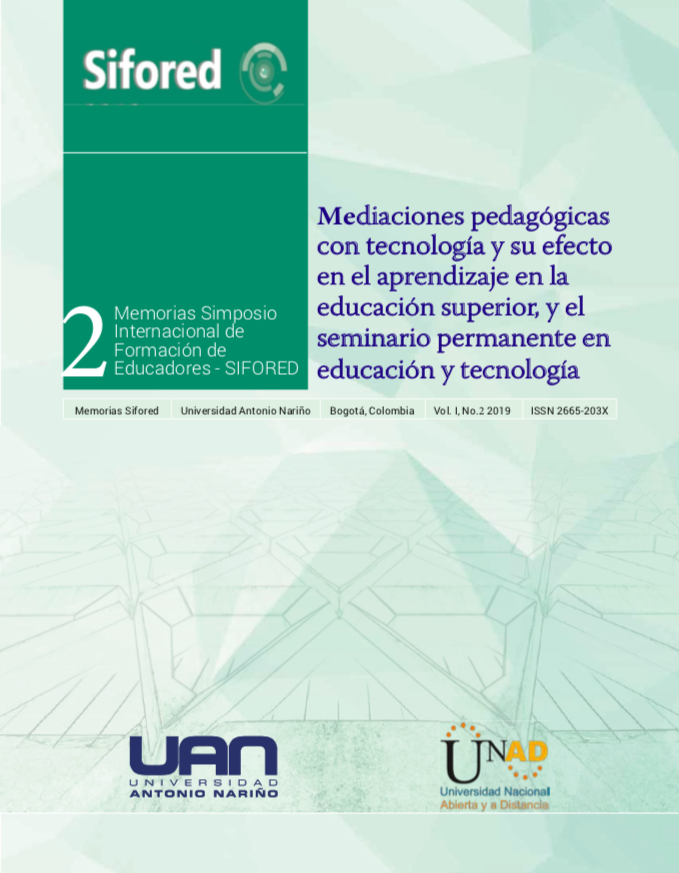OPINIONES Y DISEÑO CURRICULAR PARA LA PAZ A PARTIR DE UN FORO EN MOODLE
Palabras clave:
Procesamiento de lenguaje natural (NLP), Educación para la paz, ColombiaResumen
El texto presenta los avances de un análisis semiótico de 133 opiniones de jóvenes universitarios colombianos sobre el tema de la paz, manejado con técnicas de procesamiento de lenguaje natural (Natural Language Processing – NLP). Este trabajo busca consolidar un desarrollo curricular guiado por los preconceptos, necesidades e intereses de los jóvenes. La propuesta reconoce a los aprendices como sujetos activos involucrados en su proceso formativo, el cual llevará al diseño de un material didáctico orientado curricularmente por tres niveles de intervención: percepción, comprensión y dominio.
Descargas
Citas
Bird, S., Klein, E., & Loper, E. (2009). Natural language processing with Python: analyzing text with the natural language toolkit. “O’Reilly Media, Inc.”.
Goulah, J., & O. Urbain (2013). Daisaku Ikeda’s Philosophy of Peace, Education Proposals, and Soka Education: Convergences and Divergences in Peace Education. Journal of Peace Education 10 (3): 303–322. doi:10.1080/17400201.2013.848072
Haavelsrud, M., & O. Sternberg (2012). “Analyzing Peace Pedagogies.” Journal of Peace Education 9 (1): 65–80. Doi: 10.1080/17400201.2012.657617
Lewsader, J. & Myers-Walls, J. (2016). Developmentally appropiate peace education curricula. Journal of Peace Education 10(2), pp. 1-14. Doi: 10.1080/17400201.2016.12228527
Liu, B., & Zhang, L. (2012). A survey of opinion mining and sentiment analysis. Mining text data (pp. 415-463). Springer US.
Lum, J. (2013). Peace education: past, present, and future. Journal of Peace Education 10(2), pp. 121-123. Doi: 10.1080/17400201.2013.821835
Manning, C. D., & Schütze, H. (1999). Foundations of statistical natural language processing (Vol. 999). Cambridge: MIT press.
Pagés, J. (1997). “La formación del pensamiento social”. En: Benejam, P. y Pagés, J. (coords) Enseñar y aprender Ciencias Sociales, Geografía e Historia en la Educación Secundaria (Primera edición), Editorial Horsori: Barcelona, pp. 151- 164.
Ritchie, J., C. Lockie, &C. Rau (2011). “He Tatau Pounamu. Considerations for an Early Childhood Peace Curriculum Focusing on Criticality, Indigeneity, and an Ethic of Care, in Aotearoa New Zealand.” Journal of Peace Education 8 (3): 333– Doi: 352.10.1080/17400201.2011.621367
Shannon-Baker, P. (2012). “Elise Boulding’s Work as A Framework for Dismantling No Child Left Behind: Respect, Solitude, Imagination and Partnerships.” Journal of Peace Education 9
(2): 169–184. Doi: 10.1080/17400201.2012.699719
Stephenson, C. M. (2012). “Elise Boulding and Peace Education: Theory, Practice, and Quaker Faith.” Journal of Peace Education 9 (2): 115–126. Doi: 10.1080/17400201.2012.700196
Zembylas, M., and Z. Bekerman (2013). “Peace Education in the Present: Dismantling and Reconstructing Some Fundamental Theoretical Premises.” Journal of Peace Education 10
(2): 197–214. doi:10.1080/17400201.2013.790253
Descargas
Publicado
-
Resumen249
-
PDF84
Cómo citar
Número
Sección
Licencia

Esta obra está bajo una licencia internacional Creative Commons Atribución-NoComercial-CompartirIgual 4.0.


 Portal de Ciencia Abierta
Portal de Ciencia Abierta